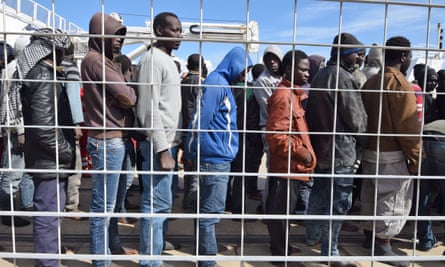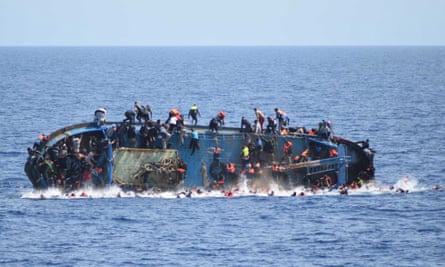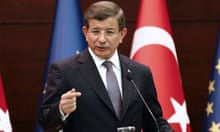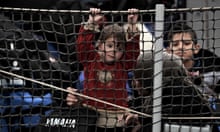Within 24 hours of the leaders of the G7 nations leaving Taormina, Sicily, the designer shops and sleek bars of the hilltop town were once again teeming with tourists. Hardly any trace of the summit remained, just some flags on the town hall, a half-dismantled stage in the Roman amphitheatre, a sign for a French press conference in the main square, and a small art exhibition including Caravaggio’s Ecce Homo.
The leaders had been invited to Taormina by their Italian hosts not just because of its beauty or views of Mount Etna but because Sicily is 300 miles from the Libyan coast, on the frontline in Europe’s battle over migration. Sicily is the island to which tens of thousands of people from Africa and Asia are heading, their first stop in Europe and an escape from poverty, war, religious conflict or personal rejection.
The Taormina summit did not prove to be the diplomatic turning point in the debate on migration that the Italian government had once hoped. The Trump administration squashed an ambitious plan for a positive statement defending the rights of refugees. Possibly the only practical outcome of the summit was that all refugee boats were banned from landing in Sicily for seven days. Taormina residents sent a discreet letter to the local prefecture after the world leaders had left saying they wanted no migrants housed in the town as it might put off the tourists.
The failure leaves migrants and refugees continuing to struggle to forge a new life for themselves in Sicilian towns such as Ragusa, two hours’ drive and a world away from Taormina. Many of those who have survived the hell of the Mediterranean sea crossing face the purgatory of Italian bureaucracy, and 18-month waits to find out whether they are to be granted asylum or instead be deported.
Numa Touray, 17, from the Gambia and now living in Palermo, summed up the choice refugees faced. “I knew the journey would be dangerous but if you have the lion behind you and the sea in front of you, you take the sea. I was 100% certain to die at home, 100% certain to die in Libya, and thought I had a 50/50 chance to survive the sea journey.”

In Ragusa, Chiekhou Giulro, a 21-year-old from Senegal, newly arrived via Libya, was sleeping rough after being served with an exclusion order by the Italian government, accused of being a smuggler.
Two years ago he had been a cattle herdsman close to Richard Toll, a town in northern Senegal. Tribal conflicts over grazing rights led him to flee, and he travelled to Sabha, an oasis city in south-west Libya, to one of the notorious connection houses where he said he witnessed innumerable beatings and death threats from the Libyan smugglers.
“They force you to ring home and then start beating you with rubber pipes, so you scream down the phone and then they try to get family to send you more money. If you do not do what they want, they beat you. The Arab people shoot people for nothing, or €50. The Asma boys, the gangs, they chase you in the street. They only care about money. In Libya, if there is a difference, it ends with the gun. They are crazy people.”
He said he escaped from Sabha and travelled to Tripoli, where he worked for six months in a storehouse to raise enough money to pay for the crossing. He paid 1,350 Libyan dinars (£750), he said, adding that different nationalities had different rates. The smugglers told him the journey would take three to four hours.
He said that soon after being set to sea in a large inflatable dinghy with 130 or so migrants on board, the Libyan smugglers started to jump off the boat on to another smaller boat that had been escorting them. They demanded someone come forward to take over steering of the migrants’ boat, and handed over a compass and the keel.
“They hit one man with a rifle butt when he refused to take over the steering. They showed me how to steer and pointed in the direction to go, but we drifted from 11 at night to 8 or 9 before being rescued. I did not know anything about boats.”
On arrival in Sicily, the police demanded to know the identity of the boat’s helmsman, and Giulro was arrested on suspicion of being part of the smuggling ring.
He insisted he had been given no option but to steer the boat, and said he hated the smugglers. With the help of Oxfam, he has a lawyer looking into his case. Oxfam also provides the arrivals living on the streets with kitbags of clothing and essentials.
Alex Ceesay, from the Gambia, also accused of steering a boat and also receiving help from Oxfam, claimed Libyan army soldiers were involved in the smuggling. Marvel Inya, from Nigeria, claimed he too had been forced to steer. Ibrahim Thiam, a mild-mannered construction worker with swollen cheeks made worse by traditional African medicine, also proclaimed his innocence.
Each had a story of long journeys, beatings, connection houses, robbery and abandonment at sea by the smugglers. None of the stories can be verified, but the men’s desire to risk so much and the brutality of the treatment of the smugglers is entirely credible.
Unicef’s refugee spokeswoman Sarah Crowe said: “In Libya the line between slavery, human trafficking and smuggling is very slender, but no one doubts the trauma these people suffer.”

The pressure being placed on the Italian government is overwhelming. So far this year more than 59,000 refugees and migrants have arrived in Italy, a third more than in the same period last year. On past patterns, a total of 230,000 will arrive this year, taking the total in the last three years to more than 600,000. A total of 1,569 people have died attempting the crossing this year, taking the total to more than 7,500 since the beginning of 2015.
Crowe said there was also “an emergency within an emergency”. More than 90% of the 28,200 under-18s who reached Italy last year were unaccompanied. None are supposed to leave the reception centre to which they are assigned until they turn 18, but more than 6,000 have absconded and are no longer traceable, living alone in cities such as Rome or leaving Italy.
The initial welcome in Sicily is tough. On disembarking at one of four registered ports, the arrivals are interviewed by police in batches of 50 to try to determine their legal status, and then sent to one of three Sicilian “hotspots” to be photographed, fingerprinted and to receive medical checks. Efforts are made to distinguish between so-called economic migrants and asylum seekers, but the legal basis for these decisions is flimsy.
They are then distributed in coaches from the hotspots to reception centres scattered all over Italy, in theory within 72 hours of arrival.
Adriana Zega, of Oxfam Italia, said: ”Some of these centres, those overseen by the local authorities, are good, providing Italian classes, focusing on integration and psychological counselling. Others, the vast majority run by the regional arm of the ministry of interior, provide no education and are subject to little scrutiny.”
In either structure, the centres’ administrators are paid €35 (£30) a day for each person in their care, of which only €2 goes to the client. Public buildings, former hotels and B&Bs are rapidly being converted. Interpreters are in high demand. Critics say it is turning into a large and under-regulated business. Some emergency centres in Sicily, notably the giant Cara di Mineo camp in a former US army barracks, have been prey to the mafia and low-level corruption.
Many people are caught in these reception centres for months, and as a result thousands abscond. In 2016, according to the UN refugee agency UNHCR, a third of those who arrived did not apply for asylum but joined the “clandestini”. The processing of asylum claims is laborious, with an initial claim taking as long as six or seven months and an appeal a further year. By the end of last year, 176,000 migrants and refugees were living in one kind of reception centre or another.
In defence of the government, the strain on resources is vast – costing as much as €4.8bn in total. The former prime minister Matteo Renzi has urged Europe not to look away, but that is precisely what Italy’s neighbours have done.
With exceptions such as Germany, Sweden and Malta, European countries have done little or nothing to meet their obligations to take refugees from Italy under a quota system set up by the EU. It is not just the governments of eastern Europe that have turned their back, risking infraction proceedings by the European commission. By 27 April, only 5,920 asylum seekers had been relocated from Italy to elsewhere in Europe – 11% of the EU’s target. Just one unaccompanied child who disembarked in Italy has been given refuge outside Italy.
Jean-Claude Juncker, the president of the European commission, lauds Italy, saying its treatment of the arrivals has “saved Europe’s honour”, but diplomats wonder how much longer it will continue.

With local and possibly national elections looming this year, the Northern League and other populist movements are increasingly vocal, insisting the arrivals are economic migrants with no right to be in Italy, The populists describe the NGOs operating rescue missions off the Libyan coast as taxi services for migrants, and challenged their sources of funding.
A Catania magistrate, Carmelo Zuccaro, has hinted at suspicion – without evidence – of collusion between the NGOs and the smugglers. “They are not all philanthropists,” he said.
There is strong local resistance to the building of new reception centres, and figures such as Matteo Salvini, the leader of the Northern League, have travelled to Sicily to denounce the facilities as “large shopping centres for human flesh”. His language is unrestrained. “You can’t any longer speak about immigration but about an invasion organised, funded and planned by Brussels with the complicity of Rome,” he said.
Salvini has said the Democratic party of Renzi and the current PM, Paolo Gentiloni, is “an accomplice to this invasion along with the [leftwing] cooperatives and the pseudo aid associations. The calls from Brussels and Strasbourg for respecting the migrant programme are ridiculous. I’m waiting for elections so that Italy can defend its borders again. Give me the interior ministry for three months and you’ll see what order and efficiency I bring back, from north to south, all over Italy.”
The Italian government is taking an increasingly tough line, increasing the number of detention centres from five to 20, cutting back on the asylum appeals process and allowing appeal judges to rely on video evidence of the first asylum claim rather than hearing the case afresh.
The interior minister, Marco Minniti, points out that the balance of nationalities of the arrivals has changed. This year one in 10 are from Bangladesh, second only to Nigeria. The change increases the likelihood that many are in search of an end to grinding poverty rather than freedom from persecution.








